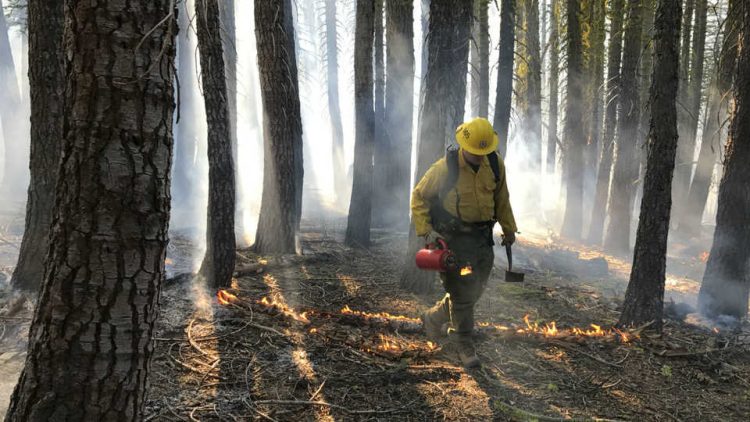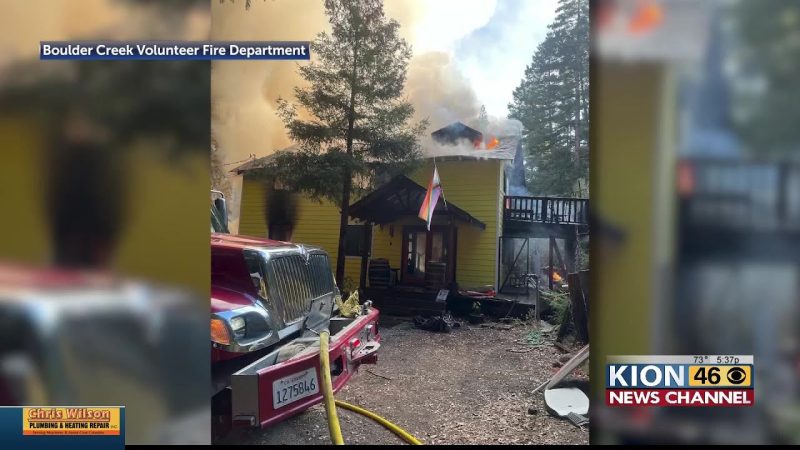Blazing Skies: The Unforgettable Fire Near Merced and the Resilience of Community”

In the heart of California’s Central Valley, Merced is known for its tranquility, agricultural richness, and a close-knit community. However, recent events have thrust this peaceful town into the spotlight, as a wildfire of unprecedented scale and intensity swept through the region, leaving behind a trail of destruction and resilience. In this article, we delve into the harrowing experience of the fire near Merced, exploring its impact on the community, the heroic efforts of firefighters, and the collective spirit that emerged in the face of adversity.
The Unfolding Disaster:
The fire near Merced ignited on a seemingly ordinary summer day, fueled by dry conditions, high winds, and an unforgiving landscape. The blaze quickly grew in size and intensity, catching both residents and authorities off guard. The speed at which the flames spread prompted widespread evacuations, with families leaving their homes, uncertain of what they would return to.
As the fire raged on, it posed a serious threat to the agricultural heart of the region. Farms, orchards, and vineyards faced destruction, raising concerns about the economic impact on local farmers and the broader community that relies heavily on agriculture.
Heroic Firefighting Efforts:
In the face of this disaster, the firefighting crews responded with unparalleled dedication and bravery. Firefighters from Merced, neighboring towns, and even those from different states converged to battle the flames. The challenges were immense, with erratic winds, difficult terrain, and the sheer scale of the inferno testing the limits of their training and equipment.
Aerial firefighting resources, including water-dropping helicopters and air tankers, played a crucial role in containing the fire and protecting communities. The collaborative efforts of ground and air teams showcased the coordinated response needed to combat such formidable wildfires.
Community Resilience:
As the fire threatened homes and livelihoods, the people of Merced rallied together in a remarkable display of resilience. Emergency shelters were set up to provide refuge for those displaced by the evacuations. Volunteers from the community, local businesses, and charitable organizations worked tirelessly to ensure that basic needs such as food, water, and shelter were met for those affected by the disaster.
Social media platforms became a hub for communication, with residents sharing updates, offering assistance, and expressing solidarity. The outpouring of support from neighboring communities and beyond demonstrated the strength of the human spirit in the face of adversity.
Impact on Agriculture:
The fire near Merced left a lasting mark on the region’s agriculture, affecting farmers and the broader supply chain. Crops were destroyed, and livestock faced evacuation challenges. The economic fallout reverberated through the community, raising concerns about the long-term impact on the livelihoods of those who rely on agriculture for their sustenance.
In the aftermath of the fire, local and state authorities worked in tandem with agricultural experts to assess the damage and implement recovery plans. Financial assistance programs were initiated to help farmers rebuild, replant, and restore their operations. The resilience of the agricultural community became a symbol of hope, showcasing the ability to overcome adversity and rebuild in the face of nature’s fury.
Environmental Consequences:
The ecological impact of the fire near Merced extended beyond the immediate destruction. The loss of vegetation and wildlife habitats raised concerns about long-term environmental consequences. Efforts to restore and rehabilitate the affected areas became a priority for environmentalists and conservationists.
Community leaders collaborated with environmental organizations to develop strategies for reforestation, habitat restoration, and the prevention of future wildfires. The disaster served as a wake-up call, prompting discussions about the need for sustainable land management practices and increased efforts to mitigate the impact of climate change on vulnerable regions.
Lessons Learned:
The fire near Merced, while devastating, offered valuable lessons for the community, emergency responders, and policymakers. It underscored the importance of proactive measures, including early detection systems, community preparedness, and investments in firefighting resources.
Local authorities revisited evacuation plans, communication strategies, and infrastructure resilience to enhance the community’s ability to respond to future emergencies. The experience also prompted a reevaluation of zoning regulations, building codes, and land use practices to minimize the risk of wildfires in the region.
Conclusion:
The fire near Merced was a chapter of adversity that tested the strength and resilience of the community. In the aftermath, as the smoke cleared and the flames were extinguished, a sense of unity and determination emerged. The heroic efforts of firefighters, the compassion of volunteers, and the unwavering spirit of the people of Merced showcased the human capacity to overcome challenges and rebuild in the face of nature’s wrath.
As the scars of the fire heal, the community is left with a profound sense of gratitude for the support received and a commitment to learning from the experience. The story of the fire near Merced serves as a poignant reminder of the fragility of our ecosystems, the importance of preparedness, and the resilience that can arise from the ashes of disaster.
-
What caused the fire near Merced?
- The specific cause of the fire near Merced may vary, but wildfires are often ignited by a combination of factors such as dry conditions, high winds, and human activities. Investigations by local authorities and firefighting agencies aim to determine the exact cause.
-
How did the community respond to the fire?
- The community near Merced responded with resilience and solidarity. Evacuations were carried out promptly, emergency shelters were established, and volunteers provided support for those affected. Social media played a significant role in disseminating information and coordinating assistance efforts.
-
What was the impact on agriculture in the region?
- The fire had a significant impact on agriculture in the Merced region. Crops, orchards, and vineyards were destroyed, posing economic challenges for local farmers. Recovery efforts, including financial assistance programs, were initiated to help farmers rebuild and restore their operations.
-
How did firefighters battle the blaze near Merced?
- Firefighters from Merced and neighboring areas, supported by aerial firefighting resources, worked tirelessly to contain the flames. The challenges included unpredictable winds and difficult terrain. The collaborative efforts of ground and air teams were crucial in managing the fire and protecting communities.
-
What environmental consequences resulted from the fire?
- The fire had environmental repercussions, including the loss of vegetation and wildlife habitats. Efforts to restore and rehabilitate affected areas were undertaken by environmentalists and conservationists. Discussions around sustainable land management practices and climate change mitigation gained prominence.
-
Were there casualties or injuries during the fire near Merced?
- Information about casualties or injuries can be obtained from local authorities and emergency services. In the wake of such disasters, ensuring public safety and minimizing harm are top priorities for responders.
-
What lessons were learned from the fire near Merced?
- The fire prompted a reevaluation of emergency preparedness, early detection systems, and community response strategies. It also highlighted the need for sustainable land management practices and discussions about mitigating the impact of climate change on vulnerable regions.
-
How can the community rebuild after the fire?
- Rebuilding efforts involve a combination of community support, financial assistance, and collaboration between local authorities and affected individuals. Learning from the experience, communities often focus on enhancing preparedness, updating infrastructure, and implementing measures to reduce the risk of future wildfires.
- What support is available for those affected by the fire?
- Local and state authorities, along with various organizations, typically offer support for individuals and businesses affected by wildfires. This support may include financial assistance, counseling services, and resources for rebuilding. Affected individuals are encouraged to reach out to relevant agencies for assistance.
-
Is there ongoing monitoring to prevent future wildfires in the area?
- Ongoing monitoring and prevention efforts are typically conducted by local firefighting agencies, environmental organizations, and relevant authorities. These efforts may include increased surveillance, awareness campaigns, and the implementation of measures to reduce the risk of wildfires in the region.





